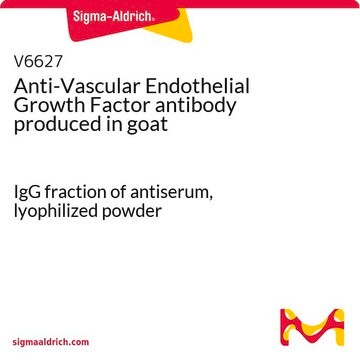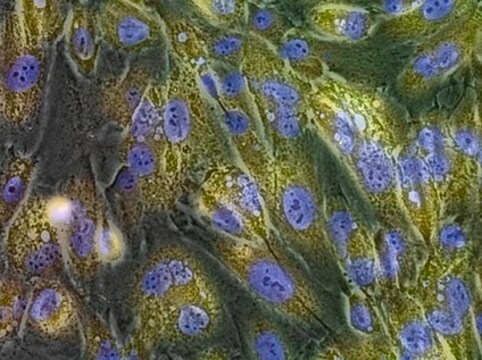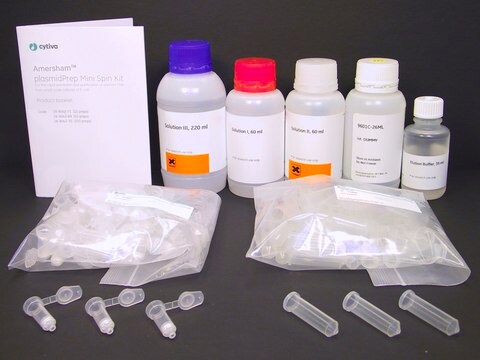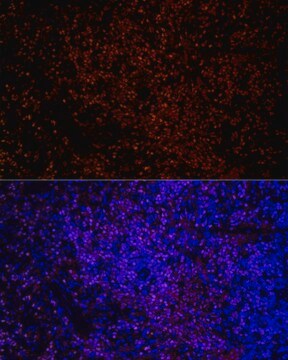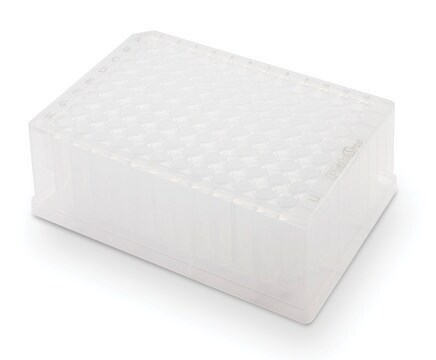SAB5801013
Przeciwciało Alpaca przeciw mysiej IgG3 (Fcγ) z pojedynczą domeną biotyny
recombinant Alpaca(VHH) Nano antibody
Synonim(y):
Rekombinowane drugorzędowe nanobiałko Alpaca z pojedynczą zmienną domeną
About This Item
Polecane produkty
pochodzenie biologiczne
alpaca
rekombinowane
expressed in E. coli
białko sprzężone
biotin
forma przeciwciała
affinity purified immunoglobulin
rodzaj przeciwciała
secondary antibodies
klon
recombinant monoclonal
Formularz
lyophilized solid
masa cząsteczkowa
14 kDa
reaktywność gatunkowa
Alpaca, mouse
metody
ELISA: 1:10000-1:50000
western blot: 1:10000-1:50000
rozmiar
0.1 mL
kolor
colorless
izotyp
VHH
Warunki transportu
wet ice
temp. przechowywania
2-8°C
Opis ogólny
Większość przeciwciał monoklonalnych jest generowana u myszy. Istnieje pięć izotypów przeciwciał (IgA, IgD, IgE, IgG i IgM) pochodzących od myszy. Każdy izotyp ma inny łańcuch ciężki. Mysia IgG stanowi 75% immunoglobulin w surowicy, a IgG jest dominującą formą pierwszego przeciwciała wytwarzanego u myszy. Mysie IgG składa się z pięciu podklas - IgG1, IgG2a, IgG2b, IgG2c (szczepy wsobne myszy z allelem Igh1-b mają izotyp IgG2c zamiast IgG2a), IgG3. Są one wysoce homologiczne i różnią się głównie regionem zawiasowym. Cała cząsteczka IgG posiada zarówno region Fc, jak i region Fab, który posiada miejsce rozpoznawania epitopu. IgG zawiera dwa łańcuchy ciężki i lekki, przy czym łańcuch ciężki ma około 50 KD, a łańcuch lekki około 25 KD. Wspólna IgG jest monomeryczna o masie cząsteczkowej około 150 kD.
VHH to przeciwciała jednodomenowe pochodzące ze zmiennych regionów łańcucha ciężkiego immunoglobuliny Camelidae. Rozmiar VHH jest niezwykle mały (<15KDa) w porównaniu do innych form fragmentów przeciwciał, co znacznie zwiększa przepuszczalność VHH. Dlatego VHH jest uważany za bardzo wartościowy dla badań, diagnostyki i terapii.
Specyficzność
Izotyp: Domena VHH IgG2b/2c alpaki
Immunogen
Opakowanie
Postać fizyczna
Rekonstytucja
Przechowywanie i stabilność
Inne uwagi
Nie możesz znaleźć właściwego produktu?
Wypróbuj nasz Narzędzie selektora produktów.
Hasło ostrzegawcze
Warning
Zwroty wskazujące rodzaj zagrożenia
Zwroty wskazujące środki ostrożności
Klasyfikacja zagrożeń
Aquatic Chronic 3 - Skin Sens. 1
Kod klasy składowania
13 - Non Combustible Solids
Klasa zagrożenia wodnego (WGK)
WGK 3
Temperatura zapłonu (°F)
Not applicable
Temperatura zapłonu (°C)
Not applicable
Wybierz jedną z najnowszych wersji:
Certyfikaty analizy (CoA)
It looks like we've run into a problem, but you can still download Certificates of Analysis from our Dokumenty section.
Proszę o kontakt, jeśli potrzebna jest pomoc Obsługa Klienta
Masz już ten produkt?
Dokumenty związane z niedawno zakupionymi produktami zostały zamieszczone w Bibliotece dokumentów.
Nasz zespół naukowców ma doświadczenie we wszystkich obszarach badań, w tym w naukach przyrodniczych, materiałoznawstwie, syntezie chemicznej, chromatografii, analityce i wielu innych dziedzinach.
Skontaktuj się z zespołem ds. pomocy technicznej

